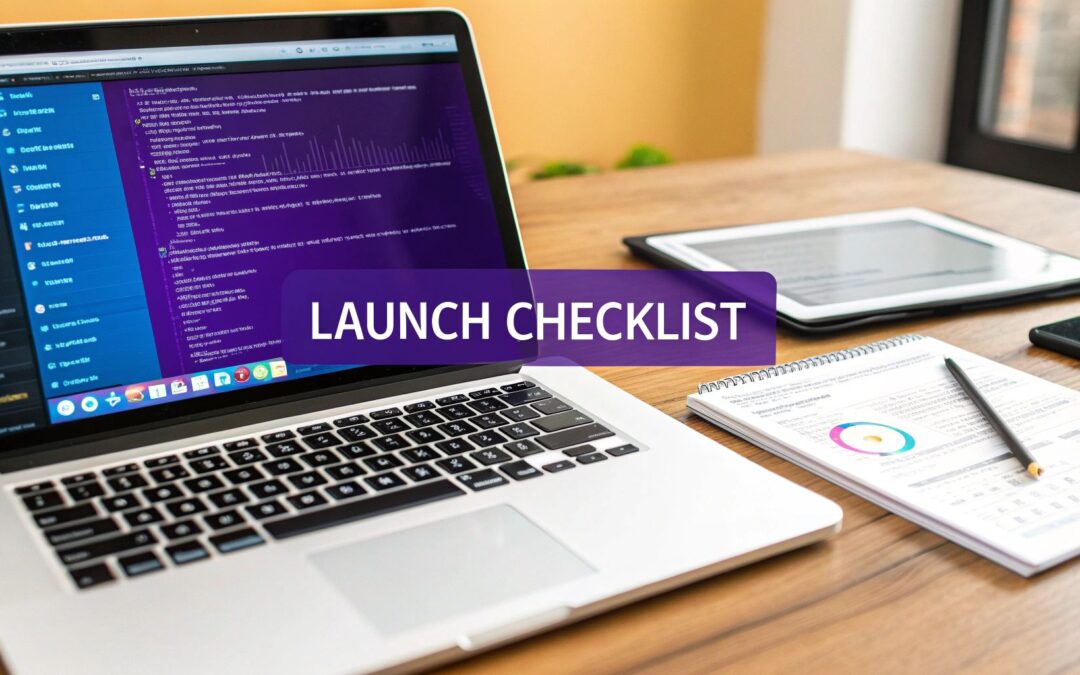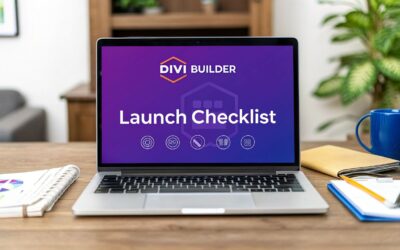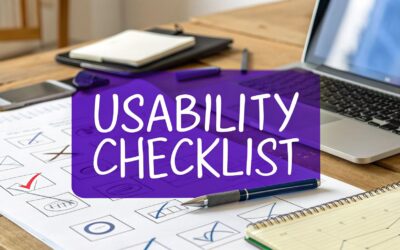Launching a new website is an exhilarating but nerve-wracking process. After countless hours of design, development, and content creation, the final moments before going live are critical. A single overlooked detail can lead to broken functionality, a poor user experience, or a disastrous first impression that undermines all your effort. This is precisely where a detailed pre-launch plan becomes your most valuable asset.
To ensure your hard work translates into a flawless debut, a thorough website launch checklist is not just helpful, it's essential. It transforms a chaotic rush into a methodical process, safeguarding your project against common pitfalls. Think of it as a final quality assurance sweep that covers every critical checkpoint, from technical performance to legal compliance.
This guide provides more than just a list of reminders. It's a comprehensive, step-by-step blueprint designed for developers, designers, and e-commerce managers. We will walk through nine crucial stages:
- Content and Functionality: Verifying every link, form, and sentence.
- Technical Readiness: Optimizing for speed, security, and cross-browser compatibility.
- SEO and Analytics: Ensuring your site is visible to search engines and ready to track performance from day one.
- Legal and Administrative: Setting up backups and ensuring all necessary legal pages are in place.
By methodically working through these items, you can confidently hit the 'publish' button, knowing you've covered all your bases for a smooth, secure, and successful launch. Let's begin the final countdown.
1. Content Review and Proofreading
A meticulous content review is the bedrock of a professional and trustworthy website. Before you even think about pushing the launch button, every single word, image, and video must undergo a comprehensive audit. This crucial step in any website launch checklist goes far beyond a simple spell-check; it involves verifying factual accuracy, ensuring brand voice consistency, and confirming that every piece of content, from headlines to legal disclaimers, is perfect.

Think of companies like Apple, whose product pages are masterpieces of clarity and precision, or the editorial rigor seen on platforms like Medium. This level of quality doesn't happen by accident. It is the result of a structured, multi-layered review process that prevents embarrassing and costly mistakes, such as forgotten "lorem ipsum" placeholder text.
How to Implement a Thorough Content Review
To execute this effectively, create a master spreadsheet listing every page and content asset on your site. This serves as your command center for the review process.
- Assign Ownership: Assign specific pages or sections to different team members. This creates accountability and ensures no page is overlooked.
- Use a Multi-Layered Approach: Start with an automated tool like Grammarly to catch basic spelling and grammar errors. However, this is just the first pass.
- Human Review is Essential: Have at least two different people read through all the content. The first reviewer can focus on grammar and accuracy, while the second can focus on brand voice, tone, and flow.
- Read It Aloud: This simple technique is incredibly effective for catching awkward phrasing and run-on sentences that automated tools and silent readers often miss.
- Check on Multiple Devices: Content can render differently across devices. Review everything on desktops, tablets, and mobile phones to ensure formatting and readability are consistent.
By systemizing your content audit, you ensure your message is clear, your brand is professional, and your users have a seamless experience from the moment they land on your site.
2. Cross-Browser and Device Testing
Your website may look flawless on your own machine, but users will access it from a vast ecosystem of browsers, devices, and operating systems. Cross-browser and device testing is the critical process of verifying that your site delivers a consistent, functional, and visually appealing experience for everyone, regardless of how they access it. This essential step in any professional website launch checklist prevents the common pitfall of alienating significant user segments due to technical glitches on their specific setup.

Consider how Netflix ensures its streaming service works seamlessly on over a thousand different device types, from smart TVs to gaming consoles. Similarly, Google’s mobile-first indexing initiative underscores the importance of a pristine mobile experience, as it directly impacts search rankings. This rigorous testing ensures that layout breaks, non-functional buttons, and distorted images don't sabotage your user experience and damage your brand's credibility right from the start.
How to Implement Comprehensive Device Testing
To ensure universal compatibility, you need a systematic testing strategy that covers the most likely scenarios for your target audience. This process validates everything from CSS rendering to JavaScript functionality across different environments.
- Prioritize Popular Platforms: Use your analytics data (if available) or market research to identify the most popular browsers and devices used by your target audience. Focus your primary efforts on Chrome, Safari, Firefox, and Edge on both desktop and mobile.
- Use Testing Services: Platforms like BrowserStack or LambdaTest are invaluable. They provide instant access to thousands of real browsers and devices, saving you the expense and hassle of creating a physical device lab.
- Test on Real Devices: While emulators are great for quick checks, they can't fully replicate real-world performance and touch interactions. Always test on a physical iPhone and Android device to catch issues emulators might miss.
- Check Different Resolutions: Your responsive design needs to be tested beyond standard device breakpoints. Drag your browser window to various widths to spot layout issues at unconventional sizes.
- Don't Forget Older Versions: If your analytics show a portion of your audience uses older browser versions, include them in your testing scope to ensure you don't leave those users behind.
3. Performance Optimization and Speed Testing
In today's fast-paced digital world, a slow website is a failed website. Performance optimization is the systematic process of analyzing and improving your site's loading speed and responsiveness. This essential part of any website launch checklist ensures that users have a swift and smooth experience, which directly impacts engagement, conversion rates, and search engine rankings. It involves a combination of techniques like image compression, code minification, and server-side enhancements to make every page load as quickly as possible.

The impact of speed is well-documented. Amazon famously found that a mere 100ms improvement in page load time boosted their revenue by 1%, while Walmart saw a 2% increase in conversions for every 1-second improvement. Initiatives like Google's Core Web Vitals have made performance a critical factor for SEO, meaning a slow site will struggle to rank. This step isn't a luxury; it's a fundamental requirement for online success.
How to Implement Performance Optimization
To achieve a high-performance website, you need a strategic approach to testing and optimization. Use a suite of tools to diagnose issues and apply targeted fixes before launch.
- Benchmark with Tools: Use tools like Google PageSpeed Insights, GTmetrix, and Pingdom to analyze your site's performance. These platforms provide a detailed breakdown of what's slowing you down and offer actionable recommendations.
- Optimize Your Images: Large images are a primary cause of slow load times. Compress images using tools like TinyPNG and serve them in next-gen formats like WebP. Implement lazy loading so images below the fold only load when a user scrolls to them.
- Minify and Combine Files: Reduce the size of your CSS, JavaScript, and HTML files by removing unnecessary characters, spaces, and comments. WordPress caching plugins like WP Rocket often handle this automatically.
- Leverage Browser Caching: Configure browser caching so repeat visitors can load your site much faster. This instructs the browser to store static files locally, reducing the number of requests back to your server.
- Choose Quality Hosting: Your server's response time is a crucial performance factor. Invest in a reliable hosting provider with a robust infrastructure, especially if you are running a resource-heavy site with Divi and WooCommerce.
4. SEO Setup and Optimization
Launching a website without a solid SEO foundation is like opening a store on a street with no name. Search Engine Optimization (SEO) is the non-negotiable process of configuring your site to be understood, indexed, and ranked by search engines like Google. This critical step in your website launch checklist involves everything from on-page elements like meta tags and keyword integration to technical configurations like sitemaps and robots.txt files, ensuring your target audience can find you from day one.

Consider how platforms like HubSpot and Shopify build powerful SEO features directly into their systems, enabling users to optimize for visibility effortlessly. Similarly, the experts at Moz practice what they preach, with their own site serving as a prime example of meticulous optimization. This strategic foresight ensures that a new website doesn't just launch into a void but instead enters the digital landscape with a clear path to being discovered.
How to Implement a Thorough SEO Setup
To execute this effectively, integrate SEO best practices into your development process from the very beginning, not as an afterthought. Use a checklist to track every essential SEO task before launch.
- Keyword Research and Mapping: Before writing content, research relevant keywords for each page. Assign a primary keyword and several secondary keywords to every important URL to guide your content creation and on-page optimization.
- On-Page SEO Elements: Write unique, compelling title tags and meta descriptions for every single page. Use header tags (H1, H2, H3) hierarchically to structure content logically for both users and search engine crawlers.
- Technical Configuration: Generate an XML sitemap and submit it to Google Search Console to help search engines discover and index all your pages. Configure your
robots.txtfile to guide crawlers on which parts of your site to access or ignore. As you finalize your SEO strategy, don't overlook conducting a thorough technical SEO audit. A comprehensive technical SEO audit checklist can guide you through essential elements for optimal performance. - Install Analytics and Monitoring Tools: Set up Google Analytics and Google Search Console from the start. These tools are indispensable for monitoring traffic, tracking keyword rankings, and identifying technical issues post-launch. For those using Divi, you can find more guidance in this pre-launch SEO checklist.
By methodically addressing these SEO fundamentals, you set your website up for long-term organic growth, making it visible and accessible to the audience actively searching for your solutions.
5. Security Testing and SSL Certificate Installation
Robust security is not an optional add-on; it is a fundamental requirement for any modern website. Before launch, conducting a comprehensive security audit and correctly installing an SSL certificate are non-negotiable steps in your website launch checklist. This process involves identifying potential vulnerabilities, hardening your site against attacks, and encrypting data to protect both your business and your users' sensitive information.
Think of the trust inspired by the padlock icon in a browser's address bar. This is made possible by SSL/TLS encryption, a standard championed by organizations like Let's Encrypt, which made it accessible to everyone. Companies like Cloudflare build on this foundation, offering extensive security suites that protect against a wide range of threats. A proactive approach to security prevents data breaches, protects your brand's reputation, and is a critical ranking factor for search engines.
How to Implement Security Testing and SSL
To effectively secure your website, you must adopt a multi-layered strategy that covers encryption, vulnerability scanning, and proactive hardening.
- Install an SSL Certificate: Your first step is to enable HTTPS across your entire site. Many hosting providers offer free SSL certificates from Let's Encrypt with one-click installation. Ensure all traffic is automatically redirected from HTTP to HTTPS to enforce encryption everywhere.
- Run Vulnerability Scans: Use tools like OWASP ZAP or a WordPress plugin like Wordfence to scan your site for common vulnerabilities, such as SQL injection or cross-site scripting (XSS). Address any identified issues before going live.
- Harden Your Website: Implement strong password policies for all user accounts, especially for administrators. Keep all software, including your CMS, plugins, and themes, updated to the latest versions to patch known security holes. For more details on this, you can learn more about website security practices on divimode.com.
- Configure Security Headers: Implement HTTP security headers like HTTP Strict Transport Security (HSTS). This tells browsers to only communicate with your server over a secure connection, reducing the risk of man-in-the-middle attacks.
- Protect Forms and Data: Ensure all forms that collect user data are secure. Verify that your data protection protocols are compliant with regulations like GDPR or CCPA, depending on your audience.
By integrating these security measures into your pre-launch process, you build a resilient and trustworthy digital presence from day one.
6. Analytics and Tracking Setup
Launching a website without analytics is like driving a car blindfolded; you’re moving, but you have no idea where you’re going or how to get to your destination. Setting up analytics and tracking is a non-negotiable step in any modern website launch checklist. This process involves implementing tools that collect, measure, and analyze data about user behavior, allowing you to make informed decisions to improve performance and achieve business goals.
Think of the detailed dashboards in Google Analytics 4, which show you everything from user demographics to the most popular content, or the integrated sales tracking within Shopify's ecosystem. These platforms transform raw visitor clicks into actionable business intelligence. Without this data, you can't measure your return on investment, identify user pain points, or optimize your conversion funnels effectively.
How to Implement a Robust Analytics Setup
A strategic approach ensures your tracking is accurate, compliant, and insightful from day one. Use a tool like Google Tag Manager to centralize your tracking scripts, which simplifies management and deployment.
- Define Your Key Metrics: Before implementing any code, determine what success looks like. Is it newsletter sign-ups, contact form submissions, or product purchases? Define these as specific goals or conversion events.
- Install and Configure GA4: Set up a Google Analytics 4 property. Unlike its predecessor, GA4 is event-based, providing a more flexible and user-centric view of the customer journey across your website and apps.
- Test Everything: Use the "DebugView" in GA4 or the preview mode in Google Tag Manager to test all your tags and triggers. Verify that page views, clicks, and conversion events are firing correctly before you go live.
- Ensure Privacy Compliance: Implement a cookie consent banner and configure your tracking tools to respect user choices, aligning with regulations like GDPR and CCPA. This builds trust and avoids potential legal issues.
- Create Custom Dashboards: Don't get lost in the sea of data. Create custom dashboards that display only the most critical metrics for your business goals. This gives you a quick, at-a-glance view of your site's health. You can learn more about how to track your website performance like a pro on divimode.com.
By embedding analytics into your pre-launch process, you equip yourself with the data needed to guide your website's evolution and maximize its impact.
7. Form Testing and Functionality Verification
Forms are the primary interactive gateways on your website, serving as the bridge between you and your audience. Comprehensive form testing is an indispensable step in any website launch checklist, ensuring that every contact form, signup process, and checkout system works flawlessly. This process involves more than just seeing if the "submit" button works; it's about verifying data integrity, user feedback mechanisms, and seamless backend integration.
Think of the intuitive, user-friendly forms created by platforms like Typeform or the robust lead capture forms from HubSpot. These experiences are meticulously engineered. A broken form is a direct barrier to conversions, leading to lost leads, frustrated users, and a damaged brand reputation. Thorough testing prevents these critical failures and guarantees your communication channels are always open.
How to Implement Thorough Form Testing
To ensure every interactive element performs as expected, a systematic testing plan is essential. Create a checklist for every form on your website to track each test case.
- Test All Field Validations: Deliberately enter incorrect data formats, like text in a number field or an invalid email address, to ensure your error messages are clear and helpful. Also, test that all required fields correctly prevent form submission if left blank.
- Verify Email Confirmations and Notifications: After a successful submission, confirm that the user receives an appropriate "thank you" message or confirmation email. Simultaneously, check that your team receives the new lead notification or form data as intended.
- Test on Multiple Devices and Browsers: A form that works perfectly on a desktop Chrome browser might break on a mobile Safari browser. Test functionality across a range of devices and popular browsers to ensure a consistent user experience.
- Check Form Submission with and without CAPTCHA: Implement a spam prevention tool like Google's reCAPTCHA to protect your inbox. Test the form with it enabled to ensure it doesn't create an unnecessary barrier for legitimate users.
- Stress-Test the Backend Integration: For complex forms tied to a CRM or payment gateway, test the entire workflow. Ensure data is correctly passed to the right systems, payments are processed, and user accounts are created without a hitch.
8. Backup and Recovery System Setup
A robust backup and recovery system is the ultimate safety net for your website, providing critical insurance against data loss, security breaches, or server failures. Before launching, you must implement a system that automatically saves your files and database, ensuring you can quickly restore your site to a working state. This vital part of any website launch checklist protects your investment, prevents catastrophic data loss, and provides peace of mind.
Think of the disciplined processes used by web hosting companies and the DevOps community. They treat backups not as an afterthought but as a core operational requirement. Proactive measures, like using WordPress plugins such as UpdraftPlus or integrating cloud services like AWS S3, automate this process, safeguarding against everything from accidental deletions to malicious attacks. Without a reliable recovery plan, you risk losing all your hard work in an instant.
How to Implement a Thorough Backup and Recovery System
To establish a resilient system, you need a documented and automated strategy. This ensures that your backups are consistent, complete, and, most importantly, restorable. To establish a robust backup and recovery system, adhere to the best practices for secure data backup.
- Automate Everything: Manually taking backups is unreliable. Use your hosting provider’s built-in tools or trusted plugins to schedule daily or even hourly automated backups of both your website files and your database.
- Store Backups Off-Site: Never store your backups on the same server as your live website. If the server fails, your backups will be lost too. Use a third-party cloud storage service like Amazon S3, Google Drive, or Dropbox for redundant, off-site storage.
- Test Your Restoration Process: A backup is useless if it cannot be restored. Regularly, and especially before launch, test the recovery process on a staging environment to ensure the backup files are valid and the restoration procedure works as expected.
- Use Version Control: For theme and plugin development, use a version control system like Git. This allows you to track changes, collaborate effectively, and roll back to a previous version if an update causes issues.
- Document Recovery Procedures: Create a simple, step-by-step guide detailing how to restore the website from a backup. This document is invaluable during a high-stress emergency, ensuring a smooth and swift recovery.
By prioritizing a comprehensive backup strategy, you build resilience into your website from day one, protecting your digital assets against unforeseen disasters.
9. Legal Compliance and Policy Pages
Navigating legal requirements is a non-negotiable part of any modern website launch checklist. Before your site goes live, you must ensure it has all the necessary legal documents and complies with relevant regulations. This protects your business from potential fines and legal action while building trust with your audience by demonstrating a commitment to their privacy and rights.
The enforcement of regulations like GDPR in Europe and CCPA in California has made these policies front and center. Websites that fail to comply face significant penalties. This step involves creating and clearly displaying key pages like a Privacy Policy, Terms of Service, and a Cookie Policy, ensuring your operations are transparent and lawful from day one.
How to Implement Legal Compliance
A proactive approach to legal readiness prevents major headaches post-launch. This requires careful planning and often professional legal advice to ensure you are fully protected.
- Identify Required Policies: At a minimum, most websites need a Privacy Policy explaining how you collect, use, and protect user data. If you sell products or services, you'll also need general terms and conditions that outline the rules of engagement for your customers.
- Implement Cookie Consent: If your site uses cookies, especially for tracking or advertising, you must implement a clear cookie consent banner. This allows users to opt in or out of different cookie categories, a key requirement under GDPR.
- Draft Clear and Accessible Language: Avoid dense legal jargon. Write your policies in plain, understandable language so your users can easily comprehend their rights and your practices.
- Ensure Accessibility: Your website should also comply with accessibility standards like the ADA (Americans with Disabilities Act). This means designing your site so that people with disabilities can use it effectively, which is both a legal requirement and an ethical best practice.
- Consult a Professional: While templates are a good starting point, it is highly recommended to have a legal professional review your policies to ensure they are tailored to your specific business activities and jurisdiction.
Website Launch Checklist Comparison
| Item | Implementation Complexity 🔄 | Resource Requirements ⚡ | Expected Outcomes 📊 | Ideal Use Cases 💡 | Key Advantages ⭐ |
|---|---|---|---|---|---|
| Content Review and Proofreading | Medium – multiple reviewers needed | Moderate – human reviewers + tools | High – error reduction, brand consistency | Pre-launch content polish, brand consistency checks | Prevents errors, improves UX, maintains brand |
| Cross-Browser and Device Testing | High – multiple environments | High – diverse devices/tools | High – consistent UX across platforms | Multi-platform websites, responsive design testing | Ensures compatibility, reduces bounce rates |
| Performance Optimization and Speed Testing | High – technical expertise needed | High – tools + possible infra changes | Very High – faster load times, better SEO | Sites needing improved load speed and conversions | Boosts speed, SEO rankings, user satisfaction |
| SEO Setup and Optimization | Medium – ongoing adjustments | Moderate – tools + expertise | High – improved traffic and rankings | New or existing sites aiming for organic growth | Increases traffic, long-term marketing benefits |
| Security Testing and SSL Installation | Medium to High – technical aspects | Moderate to High – tools + certs | High – secure data, trust, and SEO boost | Sites handling sensitive data, e-commerce, user data | Protects data, builds trust, prevents breaches |
| Analytics and Tracking Setup | Medium – setup and configuration | Moderate – tools and management | High – data-driven decisions | Any site wanting to monitor performance and behavior | Insights for optimization, performance tracking |
| Form Testing and Functionality Verification | Medium – multiple test cases | Moderate – testers and dev time | High – reliable user input and data capture | Sites with interactive forms, lead generation | Prevents lost leads, improves UX, reduces support |
| Backup and Recovery System Setup | Medium – initial setup and testing | Moderate – storage and tools | High – data safety and recovery assurance | All sites where data loss impact is critical | Data protection, quick recovery, compliance |
| Legal Compliance and Policy Pages | Medium – legal expertise needed | Moderate – consulting + updates | High – legal protection and user trust | Sites subject to regulations, collecting user data | Reduces legal risk, builds trust, ensures compliance |
Launch is Just the Beginning: Your Post-Launch Game Plan
Congratulations! You have navigated the intricate, demanding, and ultimately rewarding journey of preparing a website for launch. By meticulously working through each stage of this comprehensive website launch checklist, you have laid a rock-solid foundation. From proofreading every piece of content to fortifying your site's security and ensuring legal compliance, you’ve addressed the critical elements that separate a rushed, problematic launch from a smooth, professional debut.
This checklist was designed to be more than a simple to-do list; it's a strategic framework for quality assurance. You’ve tested across browsers and devices to guarantee a consistent user experience. You've optimized for speed, knowing that every millisecond counts in retaining visitors. You’ve configured your SEO essentials, set up analytics for data-driven decisions, and implemented robust backup systems. These are not just boxes to tick; they are the pillars supporting your entire digital presence.
From Pre-Launch Precision to Post-Launch Momentum
The true value of this exhaustive preparation becomes evident the moment your site goes live. A successful launch isn’t the finish line; it’s the starting pistol for a new race focused on growth, adaptation, and optimization. The initial hours and days post-launch are a critical observation period. Your pre-launch efforts have minimized the chances of catastrophic failure, but now your focus must shift from prevention to performance monitoring.
Think of your new website as a living entity. It needs to be fed with fresh content, monitored for health, and fine-tuned to adapt to its environment. The analytics and tracking tools you so carefully installed are now your primary diagnostic instruments.
Key Post-Launch Priorities:
- Monitor Analytics Diligently: Keep a close eye on Google Analytics. Where is your traffic coming from? Which pages are most popular? What is your bounce rate? These metrics are the first indicators of user engagement and potential friction points. For Divi and WooCommerce users, this data can directly inform which product pages or blog posts need A/B testing or enhanced design elements.
- Watch Google Search Console: Check your GSC dashboard daily for the first week. Look for indexing errors, crawl anomalies, or manual actions. Ensure your sitemap is being read correctly and that the pages you want indexed are appearing in Google's index.
- Gather Real-User Feedback: Technical testing is crucial, but it cannot fully replicate the unpredictable nature of real users. Implement a simple feedback tool or survey. Be prepared to discover minor bugs or usability issues that were missed during the staging phase. A quick response to these initial reports builds immense trust and goodwill.
The Iterative Cycle: The Secret to Long-Term Success
Mastering this website launch checklist provides a significant competitive advantage. While others are scrambling to fix broken forms, 404 errors, and security vulnerabilities post-launch, you will be focused on a higher level of strategy. You'll be analyzing user behavior, optimizing conversion funnels, and planning your content calendar.
Your website is no longer a static project but a dynamic platform for growth. The post-launch phase is where you begin the iterative cycle of measuring, learning, and improving. Did that new landing page convert as expected? Is the mobile navigation truly intuitive for your target audience? The data you collect will provide the answers and guide your next steps.
For freelancers and agencies using Divi, this proactive, data-informed approach is a powerful selling point. It demonstrates to clients that you are not just a "build and run" service provider but a long-term partner invested in their success. You are launching a powerful, evolving business asset, not just a collection of web pages. Armed with this checklist and a forward-thinking mindset, you are perfectly equipped to transform a simple launch event into a sustained engine for business growth and digital excellence.
Ready to elevate your Divi workflow and streamline tasks like those in this checklist? Divimode offers a suite of powerful modules, including layout injectors and visibility managers, that help you build smarter, not just harder. Supercharge your post-launch optimizations and create dynamic user experiences with premium tools from Divimode today.






